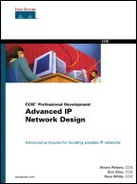Building Adjacencies
When an IS-IS router is connected to a broadcast (or multi-access) network, it immediately begins sending out IS-IS hellos. When connected to a point-to-point link, a router waits until it builds an ES-IS adjacency with the device on the other end before it determines to transmit IS-IS hellos.
These hellos are always padded to the maximum transmission unit (MTU) size of the link. This way, two routers will not build an adjacency over a link with different MTUs configured on either end.
When two IS-IS neighbors first begin bringing up an adjacency, they exchange Complete Sequence Number Packets (CNSPs) to synchronize their databases. Once a pair of routers are adjacent, Partial Sequence Number Packets (PSNPs) are used to request and send information about a subset of the link-state's database.
To reduce the problems associated with building a full mesh of adjacencies on multi-access links, such as Ethernet or Token Ring, IS-IS builds pseudonodes. One of the ISs is specified as the Designated Intermediate System (DIS); this router becomes the pseudonode on the network.
All routers attached to the multi-access network build an adjacency with this DIS rather than with one another. The DIS is selected by router priority; when there is a tie, the tie is broken by the router with the highest subnetwork point of attachment (SNPA).
DIS status is pre-emptive, unlike designated router (DR) status in OSPF. This means that if a new router with a higher priority is connected to a multi-access link, it will take over the role of DIS.
The DIS is responsible for generating pseudonode LSPs for all adjacent routers on the multi-access network. These packets are for reporting the link status of other routers to the multi-access network. The DIS also broadcasts a packet containing information on every (configurable) LSP in its database every 10 seconds onto the link it is the pseudonode for; this packet is a Complete Sequence Number PDU, or CSNP.
Other routers on the multi-access network will examine these CSNPs to determine if their database is complete. If the database isn't complete, the other routers on the multi-access network will request particular LSPs from the DIS.
One interesting point to note is the possibility for different L1 and L2 DISs to co-exist on the same multi-access network. There is a separate election process for each level of routing, and the same router may or may not be both the L1 and L2 DIS for a given multi-access link.
